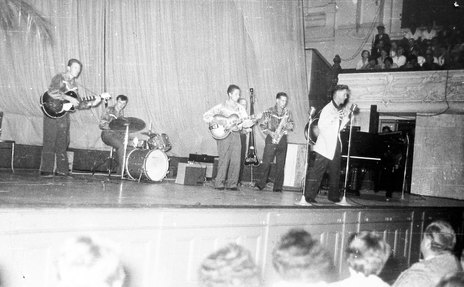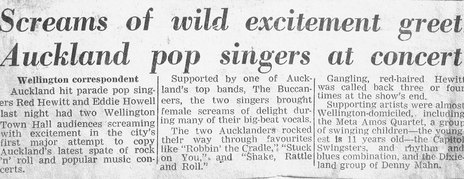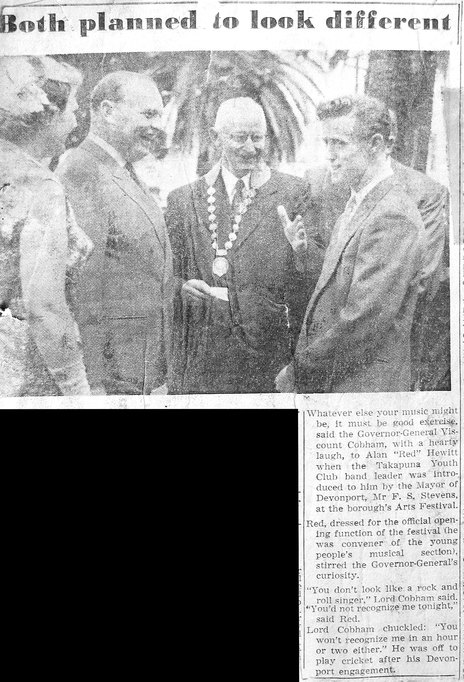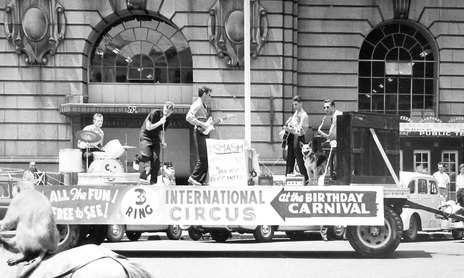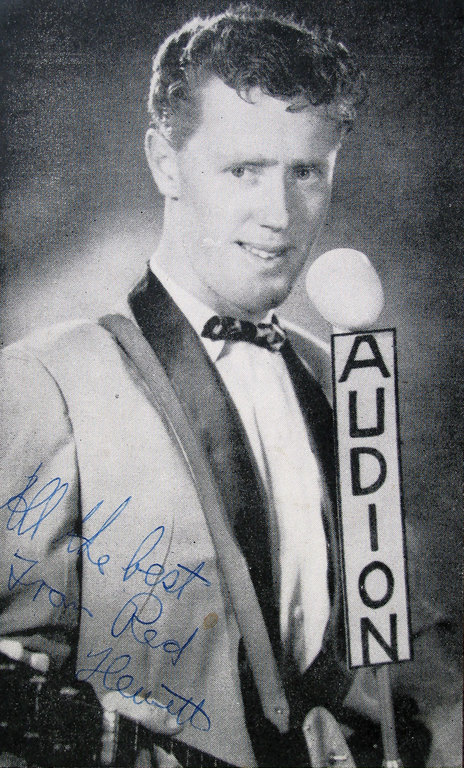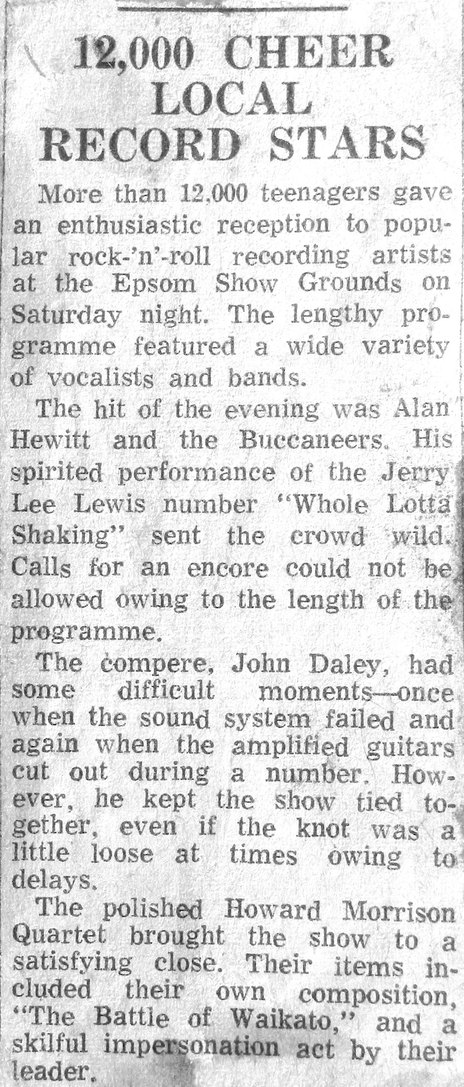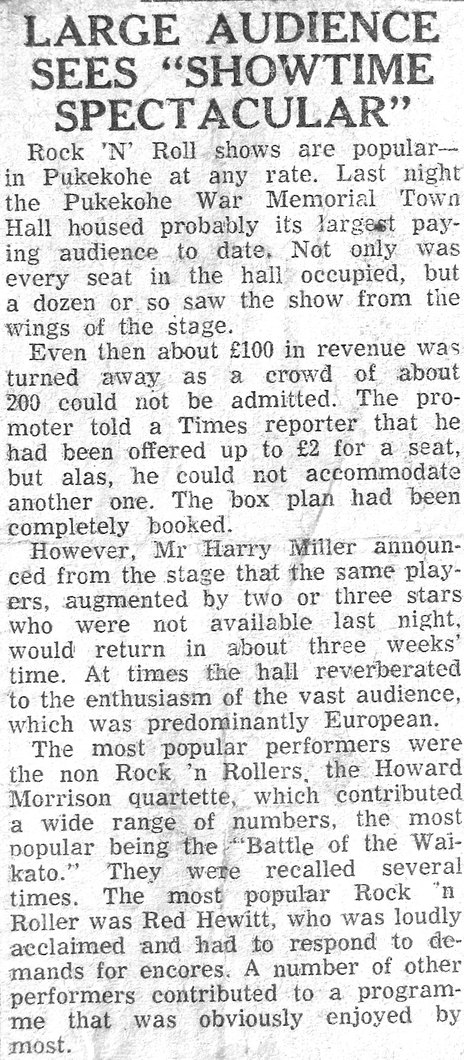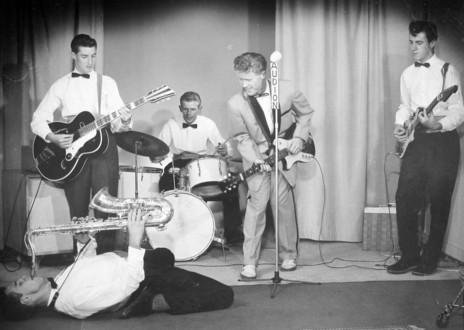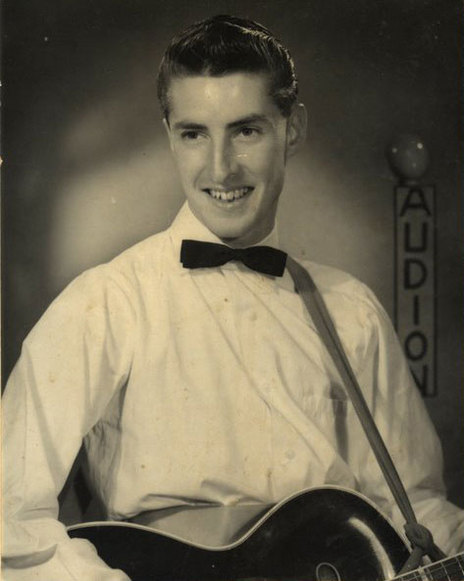Or perhaps rock historians prefer the “great man” theory of history, in which single heroic figures dominate the accepted narrative; it’s a lot easier that way, and besides, Johnny Devlin seemed a little closer to Elvis, a little more rock and roll. But that view does a disservice to Alan “Red” Hewitt, whose vigorous live shows are still fondly remembered by Auckland’s earliest rock and rollers.
He began at kindergarten, playing drums as the other children walked in (his father drummed in a military band). Country music was his first love, and by his early teens he had mastered the guitar and the harmonica, and taught himself to yodel. He first sang in front of an audience at a work function during his printing apprenticeship, performing ‘Frankie and Johnny’ in front of hired band the Hulawaiians.
“Then Elvis came along, and from then on it was a lot easier,” Hewitt recalled to radio host Jim Sutton. In 1956 he sang an Elvis song at a wedding, and formed the Buccaneers. Red handled the vocals and played rhythm, Dick Rogers was lead guitarist, Bryan McCrystal played bass and Brian Murray was the drummer. Soon, 14-year-old Veronica Tierney would join on piano.
With the Buccaneers he played teen dances on the North Shore, before taking the stage at the Jive Centre with a set of rock and roll tunes.
The group entered many of the talent quests that then proliferated around Auckland, at venues such as the Avon Theatre, Mt Roskill Hall, Māori Community Centre, Playhouse Theatre, and Have a Shot on radio station 1ZB. The Buccaneers always seemed to just miss out. They reached the finals one time, but had to decline, having been offered the O’Keefe support. Often they were beaten by Don Linden’s mime act.
When Elvis’s second film Loving You came out in 1957, a Presley sound-a-like competition was held for several weeks during the intermission at the Regent Theatre. Hewitt got a good start when he performed the same night that a contingent of bodgies and teddy boys attended, and he eventually won. With the Buccaneers he played teen dances on the North Shore, before taking the stage at the Jive Centre with a set of rock and roll tunes.
His first recording came in 1959, at Eldred Stebbing’s studio in the family home at Saratoga Street, Herne Bay. ‘The Girl in the Teddy Bear Coat’ came out on Zodiac, and showed how Hewitt had mastered the twang of an American rock and roller.
The Buccaneers had as many line-up changes as The Chills – among them was Gary Daverne, a cousin of Eldred Stebbing, who went on to an international music career as a conductor and composer. The group was renowned for its high-energy shows. During a six-month residency at the El Rancho nightclub in Mission Bay, Tierney wore heavy makeup to look older while she played piano like Jerry Lee Lewis, taking time out occasionally to give enthusiastic displays of rock and roll dancing with Hewitt, who would throw her over his shoulders.
They also performed in Whitianga, travelling from Auckland on the supply boat the Lady Jocelyn, sleeping overnight on the deck. They were paid in beer and ran out of money. Inevitably there was a beach talent quest, so they formed a skiffle band and entered as the “Bopineers”. They needed the prize money to get home, and luckily, they won.
Hewitt and the Buccaneers then jumped ship to Audion, a new label launched by two Auckland University students and a friend. In 1960 they suggested Hewitt try a song called ‘Robbin’ The Cradle’, a jailbait song written by a Canadian, Tony Bellus. Hewitt was reluctant, but his version was a smash hit, allegedly selling over 125,000 copies.
Hewitt’s style of rock and roll never ventured far from his country and rockabilly roots.
Hewitt’s style of rock and roll never ventured far from his country and rockabilly roots. After releasing another cover, ‘Tennessee Waltz’, the group returned to Stebbing for five more singles on Zodiac in the early 1960s. Many were cover versions, of country, R&B or pop standards; among them were ‘Midnight Special’ and ‘Blues Stay Away From Me’. Two songs were by writers who would become famous much later: JD Loudermilk’s ‘Half Breed’ and Dan Penn’s ‘Is A Bluebird Blue?’ On the B-side of ‘Midnight Special’ though, was a song by Auckland guitar hero Bob Paris that received a lot of airplay: ‘Beatnik Fly’.
Hewitt left for Australia in the 1960s, and opportunity knocked when Devlin recommended him for the influential TV show Bandstand. “I did ‘Half Breed’ dressed up as a cowboy, with six-guns and all,” Hewitt told Sutton in 1999. “I loved westerns, so I didn’t feel like a twit.”
After a couple of years in Australia, Hewitt came home just as the Twist was taking off. He jumped on that bandwagon, giving demonstrations of the dance while singing the song.
Eldred Stebbing wanted to nurture Hewitt as a solo artist, and formed a group around him with Peter Posa on lead guitar, but he left the label in 1961. Hewitt’s recording career stagnated after ‘Travellin Man’ b/w ‘Half Breed’, released as Red Hewitt and The Commodores by HMV later that year. His only other recording came in 1972, when he released ‘No Use Sittin’ Around’ on the Krisella label; the B-side was ‘Rockin’ The Cradle’.
Hewitt performed solo around Auckland until 1970, then formed the Red Hewitt Band, which remained together for over 20 years. In 1994 NZ Country Music Magazine said, “The band still sticks to its country roots as it always has, and Red loves to perform material by his original heroes, but they can also deliver the more contemporary Garth Brooks, Brooks & Dunn, Dwight Yoakam and Alabama numbers with the best of them … recently [we] caught Red in action belting out Chuck Berry’s ‘Memphis Tennessee’ at a private function and he knocked them dead.”
In 1991 Hewitt and the Buccaneers performed a reunion show at Auckland’s Mandalay cabaret. Four years after he died in 2006, Gary Daverne released a compilation of 20 early 1960s tracks succinctly called From the Stebbing-Zodiac-Viscount Music Vaults, Volume Two: Red Hewitt and the Buccaneers.
